
I remember my first encounter with a solar stove on a backpacking trip through the Rockies. My buddy whipped out this funky-looking reflective panel, and I thought he was joking. But an hour later, we were chowing down on a surprisingly tasty veggie stir-fry – all cooked by the power of the sun. Mind. Blown.
That’s why I’ve put together this ultimate comparison guide. We’ll dive deep into the pros and cons of both traditional and solar camping stove comparison, comparing everything from cooking performance to environmental impact. By the end of this article, you’ll have all the info you need to choose the perfect outdoor cooking companion for your next adventure. So grab a snack (you might get hungry), and let’s fire up this comparison!

Understanding Solar Camping Stoves
Alright, fellow outdoor enthusiasts, let’s shed some light on these sun-powered culinary marvels! Solar camping stoves might seem like something out of a sci-fi movie, but trust me, they’re very real and seriously cool (or should I say hot?).
So, how do these stoves work? It’s all about harnessing the power of our the sun! Solar stoves use reflective surfaces to concentrate sunlight onto a cooking area. Think of it like using a magnifying glass to start a fire, but way more controlled and way less likely to earn you a stern talking-to from Smokey the Bear.
Now, not all solar stoves are created equal. In my adventures with solar cooking, I’ve come across three main types:
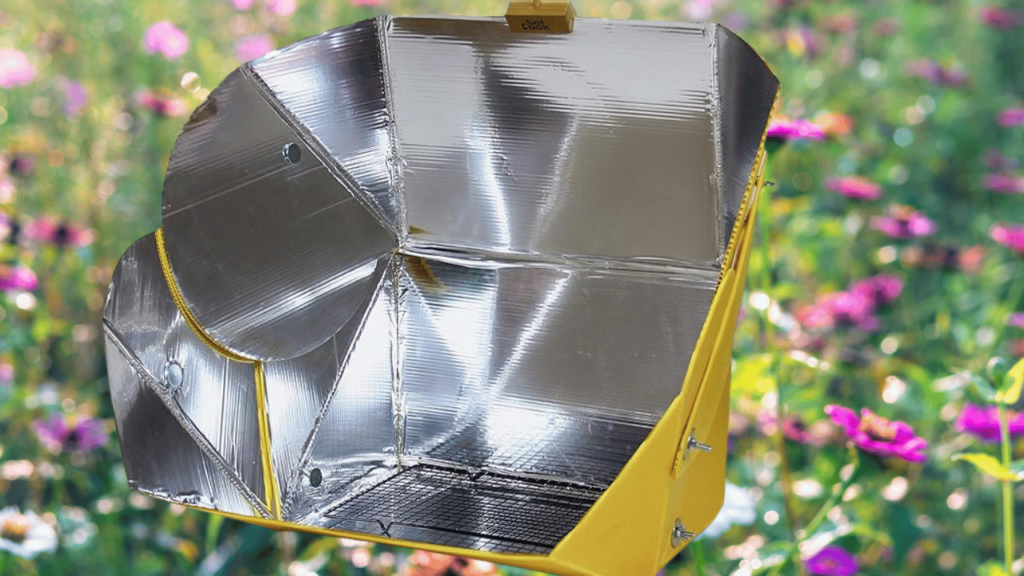
- Panel solar cookers: These are the most common and usually the cheapest. They’re basically like fancy reflective umbrellas that focus sunlight onto your pot. I once used one to heat up some canned chili, and let me tell you, it was a game-changer for lightweight backpacking!
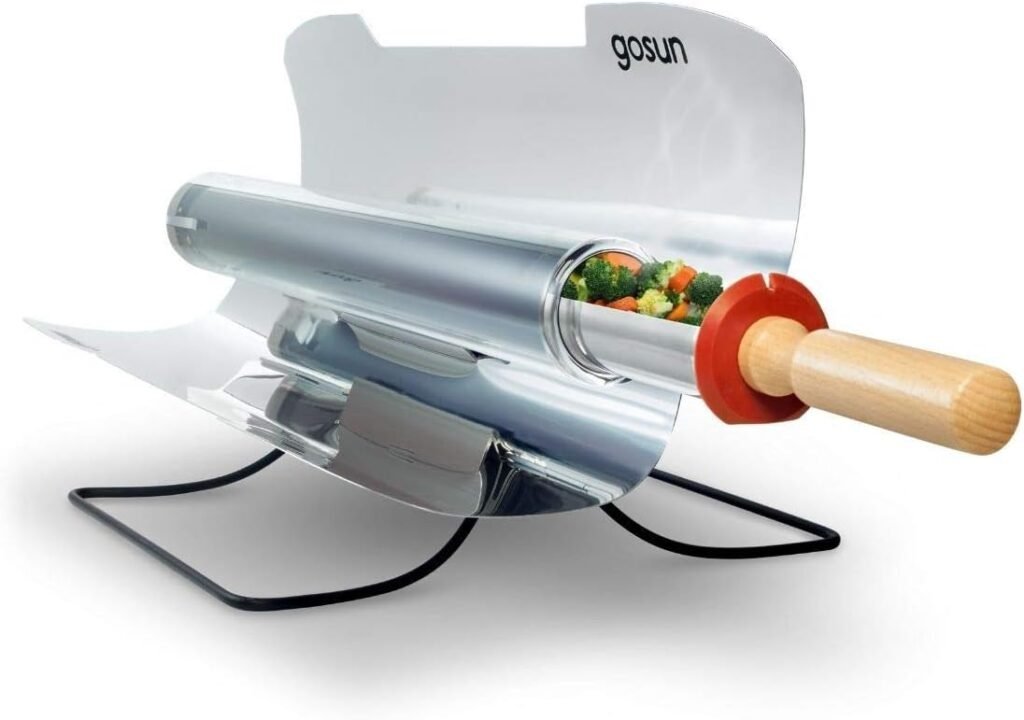
- Tube solar stoves: These look like shiny cylinders and are great for boiling water or cooking foods in liquids. I remember using one to make coffee on a frosty morning in Yosemite – it took a while, but man, that was some satisfying java.

- Parabolic solar cookers: These are the big guns of the solar cooking world. They look like satellite dishes and can generate some serious heat. A friend of mine actually seared steaks on one! Talk about solar power!
When you’re shopping for a solar camping stove, keep an eye out for these key features:
- Portability: Can you fold it up and strap it to your pack without feeling like you’re lugging around a small satellite?
- Durability: Will it survive if you accidentally sit on it after a long day of hiking? (Not that I’ve ever done that… ahem.)
- Cooking capacity: Can it handle enough food to satisfy your post-hike hunger, or will you be left nibbling on trail mix?
- Set-up time: Because let’s face it, when you’re hungry, every minute counts!
- Adaptability: Can it handle different pot sizes and types of cooking?
One thing I’ve learned the hard way: always check the weather forecast before relying solely on a solar stove. There’s nothing quite like the disappointment of realizing your dinner plans are literally under a cloud when the sky decides to open up!
But here’s the cool part – even on partly cloudy days, many solar stoves can still get the job done. It might take a bit longer, but hey, good things come to those who wait, right?
Now that we’ve got a handle on solar stoves, let’s take a quick jaunt down memory lane and revisit their tried-and-true counterparts – traditional camping stoves. Buckle up, because things are about to get fuel-icious!
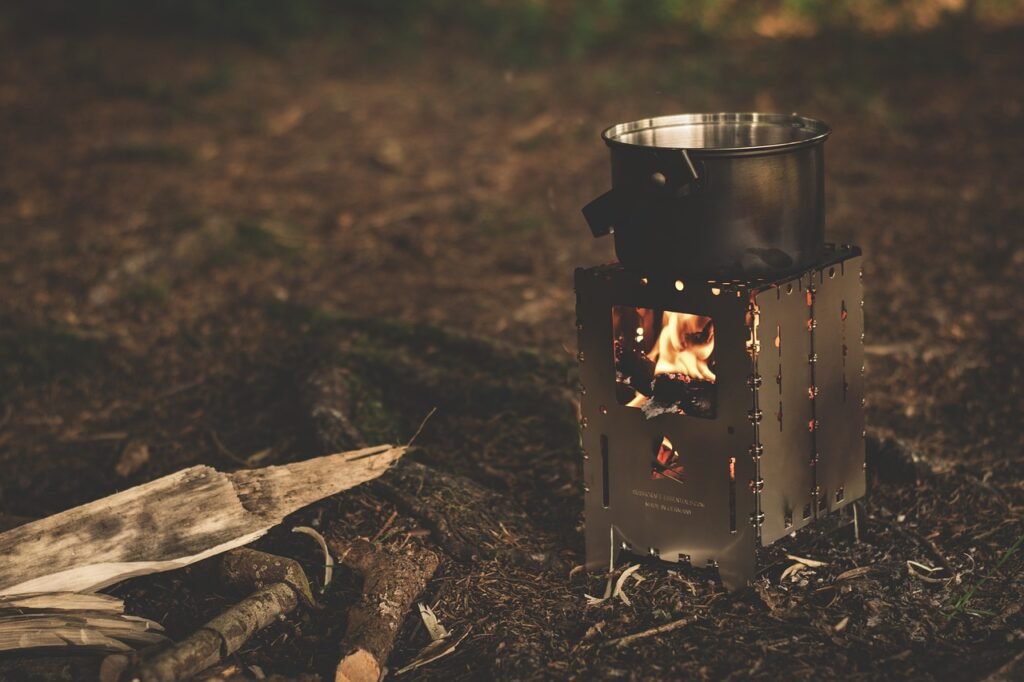
Traditional Camping Stoves: A Quick Overview
Ah, traditional camping stoves – the reliable workhorses of outdoor cooking. These bad boys have been keeping campers well-fed and happy for decades. As someone who’s burned more than their fair share of eyebrows on these things (pro tip: don’t lean too close when lighting), I’ve got a soft spot for these classic cookers.
Let’s break down the main types of traditional camping stoves you’ll encounter in the wild:

- Propane stoves: These are probably what you picture when you think “camping stove.” They run on those little green propane canisters and are super easy to use. Just screw on the canister, light it up, and boom – you’re cooking with gas! Literally.
- Liquid fuel stoves: These are the tough guys of the camping world. They can burn multiple types of fuel, including white gas, kerosene, and even unleaded gasoline in a pinch. I once used one of these on a winter camping trip in Alaska, and let me tell you, it performed like a champ in temperatures that would make a polar bear shiver.

- Wood-burning stoves: For the true wilderness enthusiasts, these stoves let you cook using twigs and small branches you find around your campsite. They’re great if you’re trying to cut down on packed fuel weight, but fair warning: your food might end up smelling a bit smoky. (Which, in my book, is not necessarily a bad thing!)
When it comes to features, traditional stoves have a few key things going for them:
- Reliable performance: Rain or shine, these stoves will fire up and get cooking.
- Fast cooking times: No waiting around for the sun to do its thing – just light and go!
- High heat output: Perfect for boiling water quickly or tackling more complex meals.
- Compact designs: Many models can fold up smaller than a paperback book.
But here’s the kicker – fuel. It’s both the blessing and the curse of traditional stoves. On one hand, you’ve got a reliable heat source that works in any weather. On the other hand, you’ve got to lug that fuel around with you. And let me tell you, nothing puts a damper on a backpacking trip quite like realizing you’ve miscalculated your fuel needs and are facing the prospect of cold beans for dinner. (Been there, done that, got the t-shirt!)
Speaking of fuel, here’s a quick rundown of what you’re looking at:
- Propane canisters: Easy to use, but not always easy to find in remote areas.
- Liquid fuel: More versatile, but requires some maintenance and can be messy.
- Wood: Free and abundant, but can be a pain to find when it’s wet out.
One last thing to keep in mind: traditional stoves can be noisy. If you’re hoping to enjoy the serene sounds of nature while you cook, you might be out of luck. I once had a stove that sounded like a small jet engine – great for drowning out my terrible campfire songs, not so great for wildlife watching.
Now that we’ve covered both solar and traditional stoves, it’s time to roll up our sleeves and dive into the nitty-gritty comparison. Get ready, because things are about to heat up in our solar vs. traditional showdown!
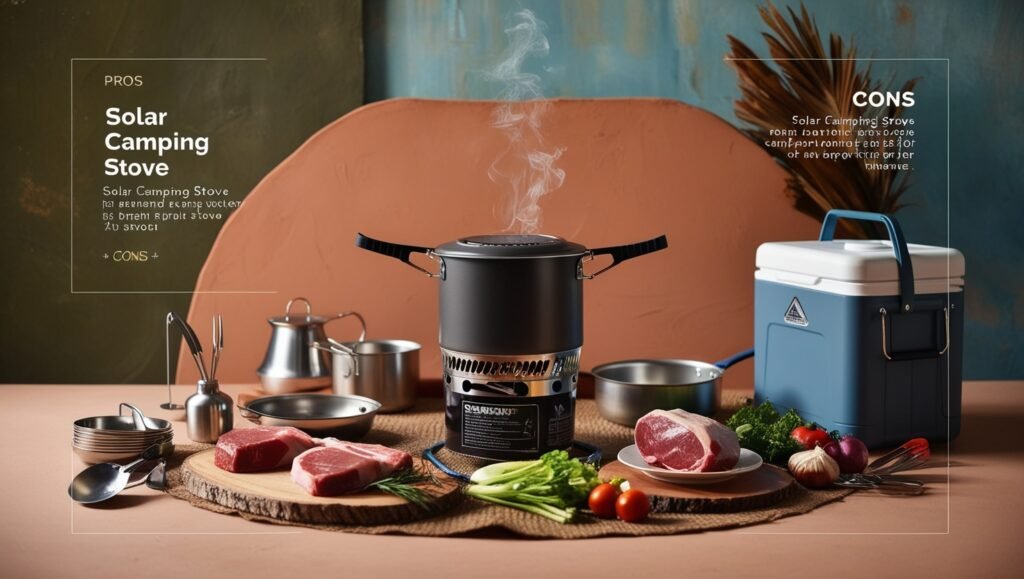
Pros and Cons of Solar Camping Stoves
Alright, fellow outdoor enthusiasts, let’s shine a light on the bright side (and the not-so-bright side) of solar camping stoves. As someone who’s both basked in the glory of sun-cooked meals and cursed at clouds for ruining dinner plans, I’ve got some real-talk pros and cons for you.
Advantages of solar camping stoves:
- Eco-friendly and sustainable: Mother Nature will high-five you for this one. Solar stoves leave no carbon footprint, which means you can enjoy your meal with a side of environmental smugness. I once cooked an entire weekend’s worth of meals without producing a single ounce of waste – talk about feeling like a camping superhero! (Lol)
- No fuel costs or weight: Your wallet and your back will thank you. Once you’ve bought the stove, the sun’s energy is free! And trust me, after a long day of hiking, every ounce you don’t have to carry feels like a blessing.
- Safe to use (no open flames): No more paranoia about knocking over a flaming stove in a dry forest. Solar stoves are like the responsible older sibling of the camping world – all the fun, none of the fire hazard.
- Silent operation: Want to hear the soothing sounds of nature while you cook? With a solar stove, the only sound you’ll hear is your stomach growling as the aroma of your meal wafts through the air.
But it’s not all sunshine and rainbows (well, actually, you do want sunshine). Let’s look at some of the drawbacks:
Disadvantages of solar camping stoves:
- Weather-dependent: This is the big one, folks. I’ll never forget the time I planned a gourmet solar-cooked meal to impress my camping buddies, only to have clouds roll in and leave us munching on trail mix for dinner. Mother Nature can be a fickle chef.
- Longer cooking times: If you’re the impatient type (or just really, really hungry), solar cooking might test your limits. We’re talking anywhere from 20 minutes for a quick boil to several hours for a full meal. Pro tip: start cooking before you think you’re hungry!
- Limited power output: While great for slow-cooking and reheating, most solar stoves struggle with high-heat cooking techniques. Forget about that perfectly seared steak – unless you’ve got one of those fancy parabolic cookers, that is.
- Generally bulkier than traditional stoves: Some models can be a bit unwieldy. I once brought a panel cooker on a backcountry trip and felt like I was carrying a small satellite dish. Great for cooking, not so great for squeezing through narrow trails!
Here’s a little personal story: On a solo trip in the Southwest, I relied entirely on my solar stove. For five glorious, sunny days, I was living the dream – zero-waste cooking, no fuel to carry, just me and the sun making culinary magic. Then, on the last day, a freak rainstorm hit. There I was, huddled under a tarp, trying to angle my solar cooker towards the tiniest patch of sunlight, all for a cup of lukewarm coffee. It was a humbling reminder that when it comes to solar cooking, flexibility (and a sense of humor) is key!
So, there you have it – the sunny side and the shady side of solar camping stoves. But how do they stack up against their fossil-fueled cousins? Let’s fire up the comparison and find out!
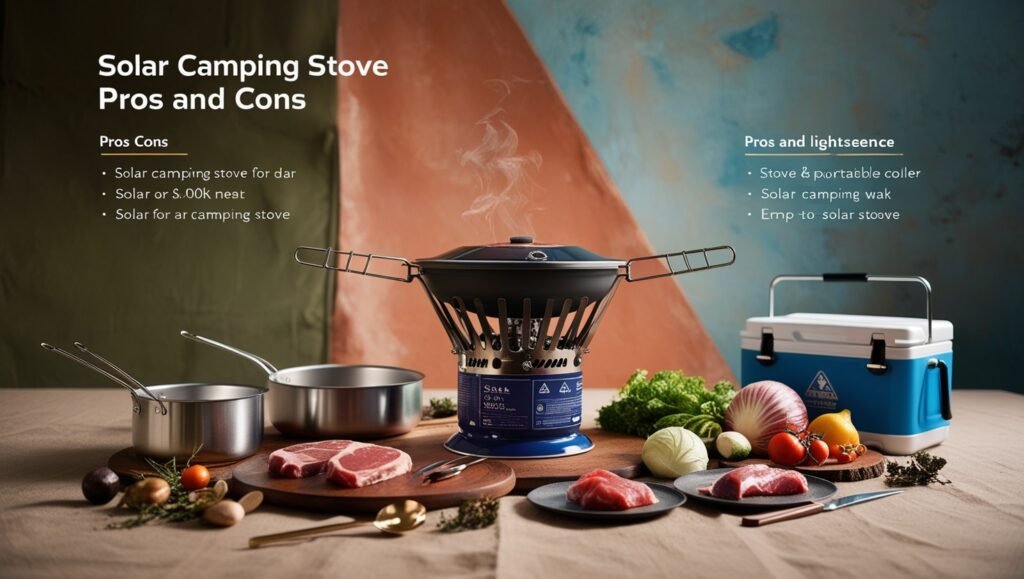
Pros and Cons of Traditional Camping Stoves
Now, let’s turn up the heat on traditional camping stoves. These tried-and-true cookers have been the go-to for outdoor enthusiasts for generations, and for good reason. But like that one friend who always brings way too much gear, they’ve got their ups and downs. Let’s break it down!
Advantages of traditional camping stoves:
- Reliable in all weather conditions: Rain, shine, or apocalyptic windstorm, these bad boys will fire up. I once cooked a full spaghetti dinner in the middle of a downpour that would’ve made Noah nervous. Try that with a solar stove!
- Faster cooking times: When you’re hangry (hungry + angry) after a long day of
- hiking, speed is your best friend. Traditional stoves can boil water in minutes, not hours. I once timed myself making mac and cheese from start to finish in under 10 minutes. It wasn’t gourmet, but it was hot, fast, and oh-so-satisfying.
- More powerful and versatile: Want to simmer a sauce? Sear a steak? Boil water for your morning coffee in record time? Traditional stoves have got you covered. They’re like the Swiss Army knives of the camping cooking world – ready for almost any culinary challenge you throw at them.
- Compact and portable designs available: Some of these stoves can fold up smaller than a paperback novel. I’ve got one that fits in my jacket pocket, which has been a lifesaver on minimalist backpacking trips. Try stuffing a solar panel in your pocket!
But it’s not all campfire songs and s’mores. Let’s look at the flip side:
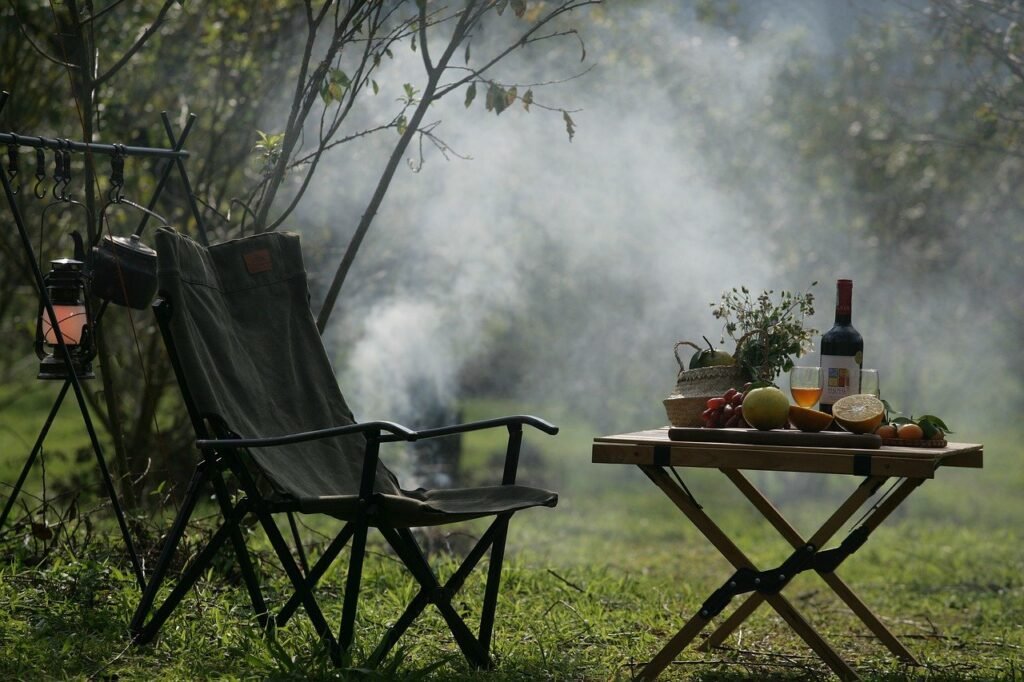
Disadvantages of traditional camping stoves:
- Fuel costs and weight: Ah, the eternal struggle of the outdoor chef. Do I bring enough fuel for gourmet meals all week, or do I sacrifice that extra canister for a comfier sleeping pad? I once miscalculated and ran out of fuel on day two of a five-day trip. Let’s just say raw oatmeal is not a culinary experience I’d recommend.
- Environmental impact: There’s no sugarcoating it – burning fuel isn’t great for Mother Nature. Every time I fire up my propane stove, I can almost hear the ozone layer sighing in disappointment. It’s a trade-off between convenience and environmental consciousness that every outdoor enthusiast has to wrestle with.
- Safety concerns (open flames, gas leaks): Remember that time I singed my eyebrows lighting a balky stove? Yeah, good times. Open flames and pressurized fuel can be a recipe for disaster if you’re not careful. And don’t even get me started on the paranoia of making sure your fuel canister isn’t leaking in your pack.
- Noise during operation: Some stoves roar like a miniature jet engine. Great for drowning out your tentmate’s snoring, not so great for enjoying the peaceful sounds of nature. I once used a particularly loud stove on a wildlife photography trip. Spoiler alert: the wildlife was not amused.
Here’s a little story from the trenches: Last summer, I was camping in Yellowstone with some friends. We had a fancy dual-burner propane stove that could probably cook a Thanksgiving dinner if we wanted. On our last night, we planned an epic feast – fresh trout, foil-packet potatoes, even a dutch oven cobbler for dessert.
Everything was going great until we realized we were running low on propane. Cue the most intense game of culinary Tetris you’ve ever seen, trying to cook everything before the fuel ran out. We ended up with slightly undercooked potatoes, perfectly cooked fish, and a cobbler that was more like warm fruit soup. But you know what? It was still one of the best meals I’ve ever had, because we were laughing the whole time.
And that, my friends, is the essence of camping cooking – it’s not about perfection, it’s about the experience. Whether you’re harnessing the power of the sun or unleashing your inner gas-powered chef, the best meals are the ones shared with good company in the great outdoors.
Now that we’ve laid out the pros and cons, it’s time to put these stoves head-to-head in a performance showdown. Get ready for the culinary clash of the titans!

Performance Comparison: Solar vs Traditional Stoves
Alright, outdoor gourmets, it’s time for the moment you’ve all been waiting for – the ultimate showdown between solar and traditional camping stoves! We’re talking a no-holds-barred, pan-to-pan comparison of these outdoor cooking titans. Let’s break it down category by category, shall we?
Cooking Speed and Efficiency:
In the blue corner, we have traditional stoves, the speed demons of camp cooking. These fire-breathing dragons can bring a liter of water to a roiling boil in as little as 2-3 minutes. I once timed myself making instant ramen (don’t judge, we’ve all been there) in under 5 minutes from start to finish. That’s fast food, camping style!
In the yellow corner, solar stoves are more like the slow-cooker of the wilderness. On a sunny day, you might be looking at 30-45 minutes to boil that same liter of water. But here’s the twist – once you’ve got your solar cooker set up, you can leave it to do its thing while you go for a swim or take a nap. It’s like having a solar-powered sous chef!
Winner: Traditional stoves take this round for speed, but solar stoves get points for multitasking potential.
Temperature Control and Versatility:
Traditional stoves shine here like a well-polished camp pot. With adjustable flames, you can go from a gentle simmer to a raging boil faster than you can say “s’mores.” I’ve managed everything from delicate scrambled eggs to a bubbling pot of chili on these bad boys.
Solar stoves, on the other hand, are more of a one-temperature wonder. Most models excel at slow cooking and reheating but struggle with high-heat techniques. However, I’ve found they’re absolutely perfect for “set it and forget it” meals like stews or rice dishes.
Winner: Traditional stoves take this one, but solar stoves have their niche.
Durability and Longevity:
This is where things get interesting. Traditional stoves have moving parts, fuel lines, and valves – all potential points of failure. I’ve had igniters give up the ghost, fuel lines clog, and valves stick. But when they’re working, they’re workhorses.
Solar stoves, with their lack of moving parts, are like the tortoises in this race – slow and steady. I’ve got a solar cooker that’s been with me for years, surviving everything from sandstorms to overzealous raccoons. As long as you don’t sit on them (yes, I learned this the hard way), they’ll last for ages.
Winner: It’s a tie! Both have their strengths in durability.
Ease of Use and Maintenance:
Using a traditional stove is usually as simple as turning a knob and lighting a match. But they do require some maintenance – cleaning fuel lines, checking for leaks, and making sure all the parts are in working order. I’ve spent more than a few frustrated minutes in the field, trying to troubleshoot a finicky stove.
Solar stoves are the epitome of “set it and forget it” cooking. Unfold, point at the sun, and you’re good to go. No fuel lines to clean, no gas pressure to check. The main “maintenance” is just keeping the reflective surfaces clean, which usually means a quick wipe-down after use.
Winner: Solar stoves edge out the win for sheer simplicity.
Now, here’s a little personal anecdote to tie it all together. Last year, I decided to do a head-to-head test on a week-long trip. I brought both my trusty traditional stove and my solar cooker. The plan was to alternate days and see which one I preferred.
Day one, traditional stove: Whipped up a quick pasta dinner in no time. Felt like a camping chef extraordinaire.
Day two, solar stove: Started my chili in the morning, went for a hike, came back to a perfectly cooked meal. Felt like a camping genius.
Day three, traditional stove: Ran out of fuel midway through cooking. Had to finish my half-cooked stir-fry over the campfire. Felt like a camping rookie.
Day four, solar stove: Cloudy day. Ended up with lukewarm soup after three hours of trying. Felt like a camping optimist (or maybe just a fool).
By the end of the week, I realized something profound – there’s no one-size-fits-all solution. Both stoves had their moments of glory and their epic fails. The key is knowing when to use each one and being prepared for when things don’t go as planned.
So, what’s the final verdict in this performance showdown? Well, like any good campfire story, it’s complicated. Traditional stoves are the speed and versatility champs, while solar stoves win for ease of use and environmental impact. In the end, the best stove is the one that matches your cooking style, camping environment, and willingness to experiment.
Now, who’s hungry? All this talk of camping stoves has me ready to fire up… well, whichever one matches today’s weather forecast!
Cost Analysis: Initial Investment and Long-term Expenses
Initial costs:
- Solar stoves: Generally $50-$300+, depending on type and quality
- Traditional stoves: $20-$200+, varying widely based on features
Long-term expenses:
- Solar: Minimal to none, occasional replacement of damaged parts
- Traditional: Ongoing fuel costs, potential part replacements
ROI considerations:
- Solar stoves pay off over time with fuel savings
- Traditional stoves have lower upfront costs but ongoing expenses
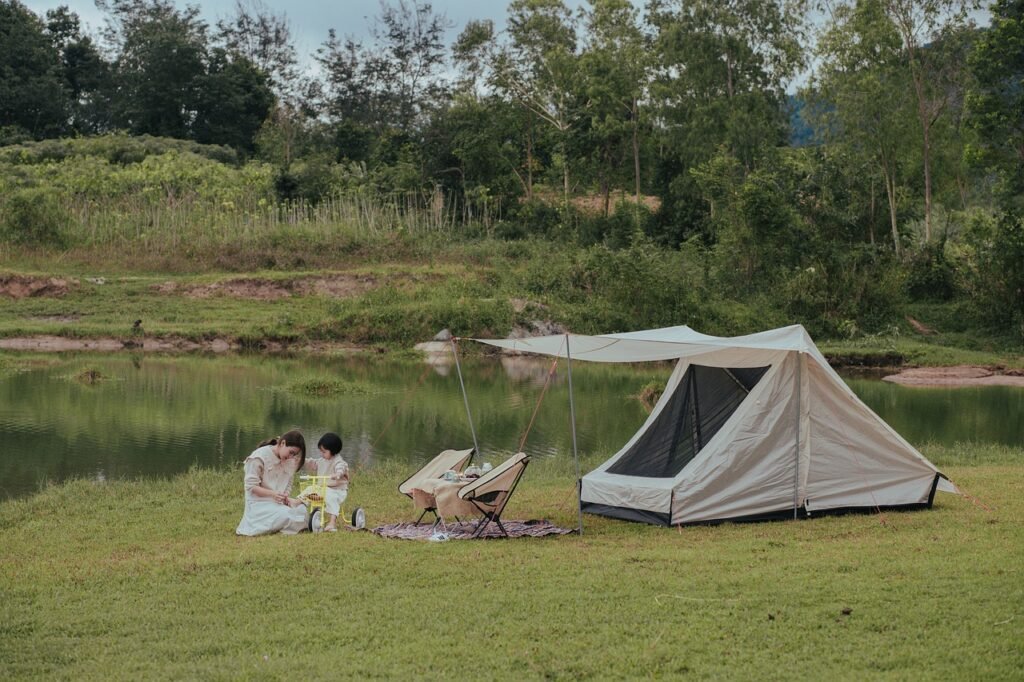
Environmental Impact: Choosing the Greener Option
Carbon footprint:
- Solar: Minimal during use, some impact from manufacturing
- Traditional: Ongoing emissions from fuel burning
Waste generation:
- Solar: Little to no waste during use
- Traditional: Fuel canisters, potential for spills
Impact on campsites:
- Solar: No fuel spills, no fire risk
- Traditional: Potential for accidental fires, soil contamination from spills
Practical Considerations for Different Camping Scenarios
Weekend trips:
- Traditional stoves often more convenient for short trips
Extended backcountry:
- Solar can be advantageous for longer trips, reducing fuel weight
Emergency preparedness:
- Both have merits; solar for long-term scenarios, traditional for immediate needs
Group vs. solo:
- Traditional often better for larger groups due to faster cooking times
- Solar can work well for solo travelers or small groups with flexible schedules
Affiliate Disclosure
This site contains affiliate links. If you purchase through these links, I will earn a small commission, at no additional cost to you. I only recommend products I trust and think will benefit you.
Best Solar Camping Stove Comparison in 2024
- GoSun Sport Pro Pack: Efficient tube-style cooker, great for 1-2 people
- All Season Solar Cooker (17) Camper: Large capacity, works in partially cloudy conditions
Making the Right Choice: Factors to Consider
- Typical camping environment and weather
- Trip duration and group size
- Personal cooking preferences
- Budget constraints
- Environmental priorities
Conclusion:
As we’ve seen, both solar and traditional camping stoves have their place in the great outdoors. Solar stoves offer eco-friendly, fuel-free cooking but require sunny conditions and patience. Traditional stoves provide reliable, fast cooking but come with fuel costs and environmental concerns.
Your ideal choice depends on your specific needs, camping style, and environmental priorities. Consider trying both types to see what works best for you. Remember, the best camping meals are often more about the experience and the company than the cooking method.
We’d love to hear about your experiences with solar or traditional camping stoves. Have you tried either? What worked well, and what challenges did you face? Share your stories in the comments below and help fellow outdoor enthusiasts make informed decisions for their next adventure!
Happy camping and bon appétit!
Related Articles
- The Ultimate Guide to Solar Ovens
- Solar-Powered Outdoor Kitchens: The Ultimate Guide for 2024
- How to Set Up a Complete Solar-Powered Outdoor Kitchen
- Best Solar-Powered Outdoor Kitchen Appliances for Off-Grid Living
- Best Solar-Powered Grills: Eco-Friendly BBQ Solutions for Your Backyard
- Portable Solar Cookers: The Best Options for Camping and Outdoor Cooking
- Best Solar-Compatible Induction Cooktops



